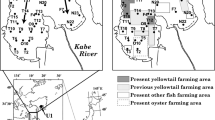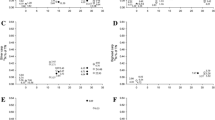Abstract
Feeds based on small (trash) fish contain much persistent phosphorus (P), such as Ca bound (Ca-P) and refractory P (Ref-P), which accumulates in high concentrations in the bottom sediments immediately below fish farms using this type of feed. This study designated three sampling locations based on their history concerning yellowtail fish farming (current, formerly or never) to investigate the sediment vertical distribution of phosphorus fractions and to test for detection of P impact on the bottom sediment. The aquaculture-free site was relatively low in Ca-P and Ref-P compared with continuous and previous aquaculture sites. The latter had high Ca-P and Ref-P content only in the depth range 17–29 cm, coinciding with the period during which aquaculture was conducted (1960–1998). The techniques used are expected to be useful to indicate bottom condition improvements and as a tracer of the effects of previous aquaculture farming.





Similar content being viewed by others
Data Availability
Data will be made available on request.
References
Brown JR, Gowen RJ, McLusky DS (1987) The effect of salmon farming on the benthos of a Scottish sea loch. J Exp Mar Biol Ecol 109:39–51
Cavalcante H, Araújo F, Noyma NP, Becker V (2018) Phosphorus fractionation in sediments of tropical semiarid reservoirs. Sci Total Environ 619–620:1022–1029
Costello C, Cao L, Gelcich S, Cisneros-Mata MÁ, Free CM, Froehlich HE, Golden CD, Ishimura G, Maier J, Macadam-Somer I, Mangin T, Melnychuk MC, Miyahara M, de Moor CL, Naylor R, Nøstbakken L, Ojea E, O’Reilly E, Parma AM, Plantinga AJ, Thilsted SH, Lubchenco J (2020) The future of food from the sea. Nature 588:95–100
Da-Peng L, Yong H (2010) Sedimentary phosphorus fractions and bioavailability as influenced by repeated sediment resuspension. Ecol Eng 36:958–962
Dhal SB, Jungbluth K, Lin R, Sabahi SP, Bagavathiannan M, Braga-Neto U, Kalafatis S (2022a) A machine-learning-based IoT system for optimizing nutrient supply in commercial aquaponic operations. Sensors 22:3510
Dhal SB, Bagavathiannan M, Braga-Neto U, Kalafatis S (2022b) Can Machine Learning classifiers be used to regulate nutrients using small training datasets for aquaponic irrigation?: A comparative analysis. PLoS One 17:e0269401
Dhal SB, Bagavathiannan M, Braga-Neto U, Kalafatis S (2022c) Nutrient optimization for plant growth in aquaponic irrigation using Machine Learning for small training datasets. Artif Intell Agric 6:68–76
FAO (2021) FAO Yearbook. Fishery and Aquaculture Statistics 2019/FAO annuaire. Rome/Roma. https://doi.org/10.4060/cb7874t
FA (2022) The state of world fisheries and aquaculture 2022. Towards blue transformation. FAO, Rome. https://doi.org/10.4060/cc0461en
Ishii Y, Komatsu N, Harigae S, Yabe T, Watanabe K, Negishi M, Iwasaki JUN (2008) Characteristics of fractional phosphorus distribution in sediment of fish farming area at Lake Kasumigaura, Japan. Nippon Suisan Gakkaishi 74:607–614. (in Japanese with English abstract)
Jia B, Tang Y, Tian L, Franz L, Alewell C, Huang J-H (2015) Impact of fish farming on phosphorus in reservoir sediments. Sci Rep 5:16617
Jin X, Wang S, Pang Y, Chang Wu F (2006) Phosphorus fractions and the effect of pH on the phosphorus release of the sediments from different trophic areas in Taihu Lake, China. Environ Pollut 139:288–295
Johnsen RI, Grahl-Nielsen O, Lunestad BT (1993) Environmental distribution of organic waste from a marine fish farm. Aquaculture 118:229–244
Kaiserli A, Voutsa D, Samara C (2002) Phosphorus fractionation in lake sediments – Lakes Volvi and Koronia, N. Greece. Chemosphere 46:1147–1155
Ministry of Agriculture, Forestry and Fisheries, Japan (2020) Statistical survey on marine fishery production. https://www.maff.go.jp/j/tokei/kouhyou/kensaku/bunya6.html. (in Japanese)
Montani S (1998) Past and present approaches to environmental management in aquaculture. Bull Soc Sea Water Sci Japan 52:202–210. (in Japanese)
Murphy J, Riley JP (1962) A modified single solution method for the determination of phosphate in natural waters. Anal Chim Acta 27:31–36
Pawar V, Matsuda O, Yamamoto T, Hashimoto T, Rajendran N (2001) Spatial and temporal variations of sediment quality in and around fish cage farms: A case study of aquaculture in the Seto Inland Sea, Japan. Fish Sci 67:619–627
Porrello S, Tomassetti P, Manzueto L, Finoia MG, Persia E, Mercatali I, Stipa P (2005) The influence of marine cages on the sediment chemistry in the Western Mediterranean Sea. Aquaculture 249:145–158
Ruttenberg KC (1992) Development of a sequential extraction method for different forms of phosphorus in marine sediments. Limnol Oceanogr 37:1460–1482
Soto D, Norambuena F (2004) Evaluation of salmon farming effects on marine systems in the inner seas of southern Chile: a large-scale mensurative experiment. J Appl Ichthyol 20:493–501
Suzumura M, Koike I (1995) Application of solid-phase extraction technique for determination of phosphorus in sediment extract. Geochem J 29:331–335
Tada K, Montani S, Suksomjit V, Hirose T, Ichimi K (2009) Settling flux at Yellowtail Sariola quinqueradiata aquaculture farm. Nippon Suisan Gakkaishi 75:383–389. (in Japanese with English abstract)
Tada K, Nakakuni M, Yamaguchi H, Kishimoto K, Ichimi K (2021) Organic matter loading of fish culture on the coastal environment. Nippon Suisan Gakkaishi 87:672–678. (in Japanese with English abstract)
Tada K, Nakakuni M, Koomklang J, Yamaguchi H, Ichimi K (2023) The impact of fish farming on phosphorus loading of surface sediment in coastal complex aquaculture. Fish Sci 89:375–386
Tu L, Jarosch KA, Schneider T, Grosjean M (2019) Phosphorus fractions in sediments and their relevance for historical lake eutrophication in the Ponte Tresa basin (Lake Lugano, Switzerland) since 1959. Sci Total Environ 685:806–817
Uede T (2007) Chemical characteristics and forms of phosphorus compounds in sediment of fish farming areas. Nippon Suisan Gakkaishi 73:62–68. (in Japanese with English abstract)
Wen S, Wang H, Wu T, Yang J, Jiang X, Zhong J (2020) Vertical profiles of phosphorus fractions in the sediment in a chain of reservoirs in North China: Implications for pollution source, bioavailability, and eutrophication. Sci Total Environ 704:135318
Wu RSS (1995) The environmental impact of marine fish culture: Towards a sustainable future. Mar Pollut Bull 31:159–166
Yokoyama H (2002) Impact of fish and pearl farming on the benthic environments in Gokasho Bay: Evaluation from seasonal fluctuations of the macrobenthos. Fish Sci 68:258–268
Acknowledgements
We thank Mr. Koji Kishimoto of the Aji Marine Station, Seto Inland Sea Regional Research Center, Kagawa University, for facilitating our field observations. Our gratitude is extended to all members of the Laboratory of Marine Sciences, Kagawa University. We thank Dr. Masahiro Suzumura and Dr. Ayumi Tsukasaki, Research Institute for Environmental Management Technology, National Institute of Advanced Industrial Science and Technology (AIST), for their useful suggestions on measurement of five different geochemical phosphorous forms.
Funding
We acknowledge support from the Kagawa University Research Promotion Program 2022 [Grant Number 22K1B002]. A part of this study was supported by the Ministry of Education, Culture, Sports, Science and Technology, Japan (MEXT) to a project on Joint Usage/Research Center– Leading Academia in Marine and Environmental Pollution Research (LaMer).
Author information
Authors and Affiliations
Contributions
Conceptualization: K.T., K.I.; Methodology: T.O., J.K.; Formal analysis and investigation: M.N., T.O., J.K., H.Y., K.I., K.T.; Writing ‐ original draft preparation: M.N., T.O.; Funding acquisition: K.T.; Supervision: H.Y., K.I., K.T.
Corresponding author
Ethics declarations
Competing interests
The authors declare no competing interests.
Additional information
Handling Editor: Gavin Burnell
Publisher's note
Springer Nature remains neutral with regard to jurisdictional claims in published maps and institutional affiliations.
Rights and permissions
Springer Nature or its licensor (e.g. a society or other partner) holds exclusive rights to this article under a publishing agreement with the author(s) or other rightsholder(s); author self-archiving of the accepted manuscript version of this article is solely governed by the terms of such publishing agreement and applicable law.
About this article
Cite this article
Nakakuni, M., Obo, T., Koomklang, J. et al. Impact of previous aquaculture (yellowtail), as persistent phosphorus, remains for decades in deeper sediments. Aquacult Int 32, 1735–1747 (2024). https://doi.org/10.1007/s10499-023-01239-9
Received:
Accepted:
Published:
Issue Date:
DOI: https://doi.org/10.1007/s10499-023-01239-9




